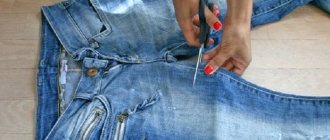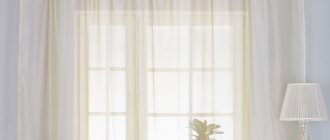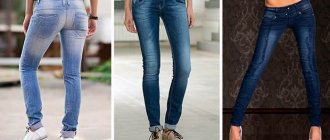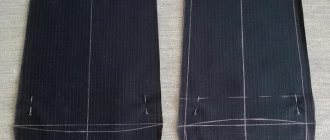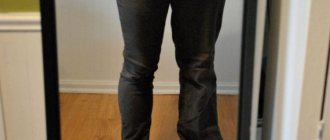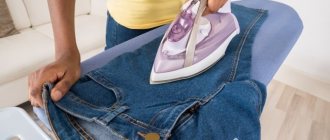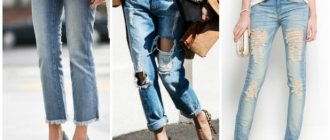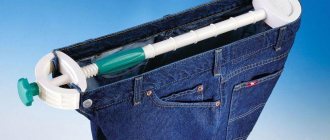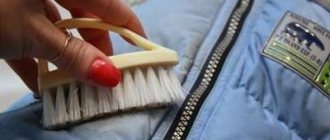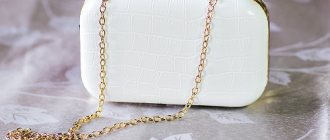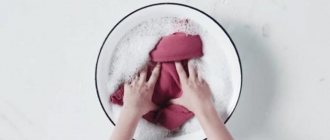At home, you can shorten your trousers without cutting off the factory seam. We'll tell you how to do this now.
Step 1
Measure the length of the trouser legs and pin them. Try it on again and make sure everything is correct.
Step 2
Connect the new line with the factory stitch so that you get a fold on the wrong side. The distance along the entire length should be the same, the side and internal seams are connected evenly.
Step 3
Now stitch as close to the factory seam as possible. Cut the fold at the back and overcast the edges by hand or with a machine.
Step 4
Before trying on, iron the seam allowance up so that it does not interfere with walking. The jeans are hemmed!
How to shorten jeans by hand without a machine
Shortening trousers without a sewing machine will not take very long. The main thing is to correctly determine the desired length.
Step 1
Try on the pants, mark the hem with chalk, soap or pins.
Step 2
Turn the product inside out, make a mark just below the first one (2 cm), remove all the pins. Make sure both legs are symmetrical.
Step 3
Cut to the desired length, fold inward, and secure the edge with pins. Hem both legs with a hidden seam. Make sure the stitches are even.
Ways to shorten a pair of jeans
Many denim pants feature nice distressed seams, mostly on the bottom. If you save them, the bending will not be noticeable. Pants can be hemmed in several ways:
- By typewriter;
- With braid;
- With the help of a web;
- With cuffs.
The process of taking measurements
There is also a creative way of folding pants. It consists in the use of finishing elements. Step-by-step work process:
- For finishing you can use various fabrics: real leather, denim material several shades darker;
- The seam can also be decorated at your discretion;
- You can make cuff cuffs out of white fabric and use colored material for the pocket edging.
A well-made fold, while maintaining a hemmed edge, helps to fit expensive trousers well, and the finishing gives a second life to your favorite trousers and will make an impression on people. It is also important to match your jeans correctly. They match almost any shoes, except summer slippers. Look good with shirts, tank tops or sweaters. Jeans are rightfully considered universal clothing. They are worn in all seasons all year round.
You may be interested in this Guide to setting up and using a Brother sewing machine
How to hem jeans at home without cutting the bottom
If you are afraid that the bottom of your trousers will unravel, you don’t have to trim the edges.
Step 1
Turn the pants inside out, try them on, and mark the desired length with chalk.
Step 2
Take it off, straighten it, and make sure that the seams match on the outside and inside. Secure the hem with safety pins.
Step 3
Sew the jeans under the factory seam. The threads should match the color of the fabric so that your stitching is invisible. Lift the fold up and iron it.
Step 4
Sew the pressed fold to the trouser leg with a hidden seam so that the leg does not fall into the resulting “pouch”. Iron it again and wear it with pleasure.
With preservation of the seam
This method of bending will require more time and experience. If you follow the instructions, it will be difficult to guess that they are folded. The factory seam will remain in place.
Required tools:
- Ruler and pin
- Scissors;
- Tailor's chalk;
- Iron;
- Sewing machine.
Work progress:
- Mark with chalk the desired length to shorten.
- Combine it with the factory seam and secure with pins.
- The seam is made using a machine as close to the seam as possible.
- The excess part of the fabric is cut off, leaving an allowance for processing.
- Process the left seam allowance using an overlocker.
- The edge with the factory seam is lowered, and the additional allowance is ironed upward using a damp cloth.
- The adhesive web is additionally laid inside and ironed.
Using a simple method, jeans can be hemmed in half an hour.
How to Hem Jeans Using Duct Tape
The lazy and easiest way to shorten pants without a sewing machine, needle and thread. For the operation you need to buy a web tape; it can be found in sewing stores. The width depends on the hem - from 0.5 to 5 cm. From a wide one, you can make a narrow one using scissors.
Step 1
Try on your pants, put on your shoes, walk around the room. Determine the desired length, fold the bottom and pin it with pins. It is better to ask someone to do this so as not to make a mistake with the size.
Step 2
Draw a chalk line for the intended edge; it should be at an angle of 90 degrees to the inside seam. Now step back 3-4 cm, draw another parallel line (it’s better to use a ruler). This will be the hem.
Step 3
Trim off any excess fabric, hemming the edge with a blanket stitch by hand or using a sewing machine if desired. Do the same trick with the other pant leg.
Step 4
Run the iron along the hem and apply the web to it from the wrong side. You need to retreat about 3-5 mm from the edge of the trouser leg. It is better to iron through gauze so that the adhesive tape does not stain the sole.
The cobwebs may begin to come off after a few washes at high temperatures. You need to set the delicate or manual mode. If there is glue left on the iron, you can clean it with alcohol.
Hemming jeans by hand
Long pants are not a reason to refuse to buy. If you don't have a sewing machine, you can fold them by hand.
Necessary materials:
- Needle, colored threads;
- Scissors and tailor's ruler;
- Pins and chalk;
- Skin.
Master Class
- Try on jeans to determine the appropriate length and make a mark with chalk;
- Another option is to turn the pants inside out and layer them with other pants of the correct length;
- Along the line of the marked mark, draw a segment symmetrical to the lower edge;
- For the hem, step back one or two centimeters from the mark and draw another stripe in chalk;
- The left trouser leg is applied to the right one, making sure that all the seams and the bottom edge of the product match;
- Using scissors, cut off excess fabric;
- Next, the raw cut is turned inward by 1.5 cm. If the fabric is stiff, you can run an iron over it.
- Fold the cut over again, attach tailor's pins and make a basting seam;
- Similar actions are performed with the second pant leg;
- Next, pull out the pins;
- Thread the thread through the needle, making a knot at the end;
- Mask it under the turn and process the bottom with the seam forward with a needle;
Important! When hemming, the length of the stitches must be the same so that the seam is of high quality and neat.
When both legs are folded, remove the basting threads.
To create abrasions, the edges are treated with sandpaper.
How to make abrasions at a seam
You will need a brush, a spray bottle of water and fabric paints.
- Wet the edges of your pants with water from a spray bottle.
- Mix purple and blue paint and apply with a brush to the machine seam area. Let it dry. To speed up the process, use a hairdryer.
- To imitate abrasion, you need to gather the edges. Take a thread and a needle, make large stitches (about 0.5 cm) at the top and bottom, and gather the fabric into an accordion. They don't have to be even.
- Wet your jeans again with water. Load up some white paint to keep your brush semi-dry. Lightly move along the gathers and hem of the legs.
- Once the paint has dried, you can unravel the stitches. Now the seam is difficult to distinguish from the factory one.
Hemming Instructions
In addition to different techniques for processing the bottom of jeans, there are instructions for performing work on changing the length depending on the model and cut of the product. You can process the bottom of the trousers, depending on the density of the fabric, the model of the product and the style in which the jeans will be used in the future.
For the length of breeches or shorts
Jeans can be shortened not to the length of your leg, but turned into breeches or shorts. Today, the trend is short denim shorts with long fringe along the edge of the product. When changing the model of jeans, you must carefully and consciously outline the length of the new product. Since excess fabric will be cut off, it is advisable not to miscalculate the length of the product.
Instructions for converting jeans into shorts (breeches):
- It is necessary to outline the new bottom line of the product on the person who will wear it. This is especially important when converting trousers into shorts, since the structure of the buttocks makes adjustments to the length of the shorts.
- Using chalk or a marker on the fabric, you need to mark the length of the product on the surface of the outer side seam and with a second mark mark the length along the back panel of the trouser leg. If a person has high, dense buttocks, then a straight, even bottom line of the product will not work out (part of the fabric will stretch upward and the bottom line along the back panel will sag slightly).
- To avoid deformation of the fabric, it is recommended to add an allowance for the back half of the jeans of about 1 cm (it is placed in the center of the trouser leg and reduced to nothing at the side seams).
- When designing the bottom of shorts or breeches, it is necessary to take into account the model of jeans from which the alteration is being carried out. If the trousers have a straight cut, then you need to taper the legs along the inner side seam (depending on the width of the trousers, add 1 - 3 cm to the taper).
Before final stitching the hem, it is recommended to iron the lapel and carry out a test fitting.
With wavy bottom
The decorative design of the bottom of the jeans in the form of a wave or a geometric slope in relation to one of the seams is done using a hem, which is cut out of dense thin fabric to match the color of the jeans or, conversely, in a contrasting shade.
Instructions for finishing the edge of jeans using a hem strip:
- Before starting work, you need to decide on the length of the product and the shape of the bottom line. To do this, mark the length of the product along the outer side seam with chalk.
- The trousers are laid out on the table surface and a wavy line is drawn along the front side with chalk. A seam allowance of 0.5 - 0.7 cm is laid down from it.
- You need to cut off the excess fabric along the seam allowance line. You need to cut it with sharp scissors, grabbing two layers of fabric on one pant leg. The same manipulations need to be done on the second leg.
- The fabric for hemming the product (an additional piece of the selected color) must be folded in half and placed down the figured edge of the jeans. It is necessary to duplicate the wavy edge on the cutting material with chalk or a marker, then cut along the intended line.
- The front part of the hem strip needs to be folded with the front side of the jeans and two types of fabric should be basted along the seam allowance line. Then you need to turn the hem inside out (inside the trouser leg) and align the processed cut at the bottom of the trousers, iron using a steam iron.
- You can attach the fabric from the wrong side using adhesive tape or secure it with stitches along the side seams of the trousers.
This method will allow you to create an original design for the bottom of denim trousers or shorts, but will require additional materials and effort.
With a jagged raw edge
The easiest way to give jeans a stylish and original look is to create a “torn edge” at the bottom of the product. In the same way, only with the help of scissors, you can turn skinny jeans into breeches or shorts.
To get a “torn edge”, you need to use scissors to make cuts on the side seams of the trouser leg with a depth of 1 - 2 cm. Since they may have compaction due to the processing of cuts and a decorative seam, it will be difficult to tear thick denim fabric in these places. Then you need to apply force and tear off the excess fabric from the panel. In some cases, additional transverse threads are pulled out with a needle to create a fringe.
With fluffy short fringe
This method of processing the bottom of jeans falls into the category of “light” work. Most of the time will be spent creating fringe along the bottom edge of the legs.
Technique for making the bottom of jeans with short fringe:
- It is necessary to put on trousers and use chalk (soap, marker) to mark the desired length of the product.
- You need to lay out the trousers on the table and use a ruler to draw a straight line, which indicates the length of the trouser leg. It is required to put down 2 - 3 cm (the fabric from which the fringe will be made).
- It is necessary to cut off the trouser leg along the second line with sharp scissors; do not process the edge of the product.
- You need to take a regular sewing needle and gradually pull out the cross threads from the denim. They need to be removed to the line that indicates the length of the product. Thus, you will get a fringe 2 - 3 cm long.
To successfully apply this method of processing the bottom of jeans, you need to accurately mark the length of the product, since it is impossible to correct the length later.
With long fringe
In addition to decorating the bottom of the product with a short fringe, you can create a decorative design with longer threads and various shapes. For example, it will decorate the edge of the product along an oblique line. However, such a design will require patience and geometric markings along the front side of the jeans, according to which the transverse threads will be pulled out of the fabric. The technique of making fringe using a needle is described above in the article. This decoration is performed on thick cotton denim fabric.
On them, the separation into fibers is easier, and the fringe turns out to be voluminous. The more elastin there is in denim, the more difficult it will be to achieve the “fringe” effect. Denim fabric differs not only in the color and composition of the threads, but also in the way they are weaved. The choice of trouser model for sewing and the duration of their use depend on this.
What types of denim are there?
| Fabric type | Characteristics |
| Denim | The most common type of denim, in which dyed and undyed threads are woven, which come in different thicknesses and compositions. |
| Broken twill | Dense fabric with a complex angular weave of threads that form a visible scar on the surface of the fabric. |
| Gin | The fabric with a predominance of cotton fibers is soft and easy to wipe clean when worn. |
| Stretch | The material has high elasticity, which depends on the percentage of artificial elastin threads in the fabric, is easy to clean by washing, and does not wrinkle. |
| Chambry | Thin fabric from which summer collections are sewn. |
| Eikru | Denim fabric is made from natural cotton fibers that do not dye, and is dense. |
To shorten jeans using any of the methods described above, you need to decide on the density of the fabric and the length of the product. Without cutting the bottom, you can only roll up trousers made of light fabric. The easiest way today is to process the bottom of the product using hot-melt tape. You don't need scissors and needles for this, you only need an iron and tape.
How to lengthen jeans
Our advice will help in situations where the trousers have shrunk after washing, the child has grown, and the trousers have become a little short. You can take it to a studio or save money and increase the length at home.
Wet
If you don’t want to bother with sewing, you can try stretching wet jeans. First you need to wash them.
- Fill the bathtub with water, dissolve one capful of baby shampoo, and stir. The liquid should be warm, never hot. Immerse the jeans in there and let them lie in the soapy solution for half an hour.
- Take it out of the water and wait for the water to drain. Don't twist them. After this, wrap the trousers in a terry towel to make a “roll”. Squeeze the fabric to absorb the water into the towel. Change to dry as needed.
- When most of the liquid has been absorbed, pull the fabric down from the waistband. Don't make sudden movements. After reaching maximum tension, leave to dry in a horizontal position.
Do not miss
- Do not miss
Whether it fits or not: how to stretch jeans at home
Decorative finishing
You can lengthen women's or children's pants by trimming them with fringe, frill, lace - there are many options. Sew the decorative element underneath or over the factory seam. But by betting you can not only increase the length, but also the width. To do this, open the inner seam and lice a triangular piece of fabric.
Adjustment
This method can actually lengthen your trousers by up to 2.5 cm.
- Open the factory seam using sharp scissors and pull out all the threads. This is good to do while the trousers are new and there is no strong contrast.
- Wash, dry as usual, iron the fabric so that there are no creases or folds.
- Try on the desired length of trousers. If you increase the width of the entire hem, you will have to sew a piece of fabric or braid to the edge.
- Machine stitch the fabric and the edge of the trouser leg, try it on again, pin the hem.
- Tuck the fabric, iron it, blind stitch it by hand or machine stitch. You can make a hem using a web tape.
Correctly marking the length
There is no point in adjusting the length based on an old pair of pants. Jeans become deformed during wear, and even if both pairs are the same size and model, they may fit differently when worn.
New jeans are worn with a belt and shoes. It’s good if there is a large mirror in the house, you need to look at yourself from the side so that the length of your pants in front and behind are clearly visible.
The trouser leg is folded inward and pinned. At the back, the bottom of jeans with an average width of 24-26 cm should reach the heel, wide flares cover the heel halfway. Skinny jeans 20-23 cm due to their small width fall above the heel.
Basic Rules
Studying the rules will help you do your work without any marks, and the appearance of your jeans neatly.
- Before sewing, the product must be washed and ironed so that there are no folds or creases.
- Jeans should be measured first from the wrong side to mark the folds, then from the front.
- The fitting should be with the shoes with which you will wear this model. Trousers should not be gathered or accordion-folded.
- Before sewing, the pants should be laid out on a flat surface, the waistband, inner and outer seams should be pinned together.
- Denim should be cut with sharp scissors (these are sold in sewing stores).
- The threads and needle must be of the appropriate color and size.
- To flatten thick areas, you need to tap them with a hammer.
- If the machine cannot cope with thick fabric, then it is better to hem it by hand. Make sure the stitches are neat and don't jump.
- Open edges should be sergeed, otherwise they will quickly unravel and hang fringed.
- After finishing sewing, the jeans need to be ironed again.
Required materials and tools
To exactly replicate factory processing, you need an industrial machine. Most home sewing machines do not sew through multiple layers of denim. It’s good if you still have an unpretentious machine from your grandmother, it will do the job better than modern “seamstresses”. In addition to heavy equipment, you will need:
- sharp scissors, ideally tailor's No. 12;
- machine denim needles No. 100-130;
- threads to match the fabric No. 40 and finishing threads No. 20;
- tailor's chalk or regular soap;
- iron with steam.
A short list will be useful for performing the most technologically advanced hems on a home sewing machine.
Tailoring tricks
You don't have to buy expensive clothes to look stylish. It is enough to keep up with the fashion of the current season. In 2022, it is fashionable to leave the inside out. The cuff part will look very original if the front of the trousers is darker and the back is lighter.
Another fashion trend for the 2020-2021 season will be jeans with high and large bends. Be prepared for all the attention to be directed to the lower part. Shoes should be clean, neat, fashionable.
These cuffs will look chic with fitted pants, even khaki ones. Classic jeans can also be refreshed with wide cuffs.
For dark colors, the cuff width can be made up to 6 centimeters. On thin trousers, experiment with a hem 3 centimeters wide, folded three times, but a little carelessly.
If you have a thin silhouette, you can make yourself look a little bigger by wearing straight classic trousers with a hem of 4 to 5 centimeters. Stocky men and short women should not strive for this fashion, that is, carelessly tucking up their trouser legs. This technique will only highlight the shortcomings of your physique. Fold the cuff once to a width of 2 centimeters.
Current styles of men's jeans
There are a large number of models of men's jeans. Nevertheless, the most popular and popular are three styles:
- regular (classic cut),
- slim (narrowed),
- skinny (very narrow).
Each of them has its own advantages and disadvantages:
- Classic men's jeans are timeless and fashionable; they are always in demand in a man's wardrobe. They are easy to recognize by their cut: they are straight from the hip and slightly tapering towards the bottom. Suitable for any body type. Indispensable for those with wide hips and calves, as well as for athletes with pumped up legs.
- The second style is skinny jeans, probably the most popular in the modern world. They are a variation of the classic ones. They are distinguished by a more advanced cut: they fit tightly around the hips, and from the knee they are straight and slightly tapered. They highlight the figure well.
- The third style is skinny, very tight jeans. Very popular among teenagers and young adults. They fit snugly around the hips and calves, making them good for those with thin legs. When choosing this model, you need to be completely confident in yourself, as they will highlight all the flaws of your figure.
What kind of jeans are rolled up and why?
Pants are very difficult to buy so that they are the perfect length right away.
There are people who just like to roll up their jeans, they are called “raw denim lovers”.
To do this, the trousers are sold with wide legs that are too long so that you can experiment with their bottoms.
Also, you don’t always want to walk with long bottoms; it’s more convenient when the bottom of the trousers doesn’t interfere with walking.
Plus, the cuffs add a certain style to the pants!
How to tame without scissors
To reduce the length of the jeans, turn them inward. When doing this job, you will do without scissors. This procedure can be done with skinny jeans and stretch jeans.
Turn up step by step:
- Turn the jeans inside out.
- Fold the leg to the desired width.
- Iron to even out the edges of the trouser leg.
- Do steps 2 and 3 with the second pant leg.
- Turn the product right side out.
- Iron the bottom again.
A denim vest and a geometric print shirt will look great with these jeans.
Pair crinkled jeans with moccasins, slip-ons or loafers.
Adviсe
- The loosely rolled bottom of the pants looks more original on loose-fitting models.
- On models made of light fabric, you should not make a voluminous hem, so as not to add a couple of kilograms to your figure.
- On flared jeans, cuffs will look ridiculous and ugly.
- Ballet flats are inappropriate with rolled-up trousers.
Which jeans can be rolled with a wide hem and which with a medium hem? On dark-colored jeans, a wide hem will be much more appropriate, and on light-colored jeans, a medium hem will be more appropriate.
Jeans length and shoes
Classic men's jeans can be combined with any shoes: classic boots and shoes, loafers, moccasins, sneakers, sneakers, brogues, ankle boots, etc. The length of the legs should cover the edges of the shoes. But to add polish to your look, you can roll up your jeans, showing the edges of your boots or exposing your ankles.
Skinny jeans can also be combined with any shoes, both sneakers and classic boots. The length of the trouser legs should reach the edge of the boots, and it is also permissible to tuck them.
As for the very narrow skinny model, it is not advisable to combine them with classic men's shoes intended for a business wardrobe. Moreover, the business dress code does not allow wearing this type of jeans to the office or to business events.
How does the length of jeans affect your appearance?
Appearance is very important for a modern person. When buying clothes, he focuses not only on the quality of the item, but also on relevance and compliance with fashion trends. First of all, people judge each other by their clothes. And this is correct, because a well-dressed and stylishly dressed person is attractive, while a poorly and out-of-date-dressed person seems behind the times and overly conservative.
Therefore, it is important to choose jeans of a modern style, and most importantly, the right size. An important factor that can favorably highlight a man’s appearance is the correct length of men’s jeans. When it comes to length, the following mistake is usually made: the pants are too long.
Excessively long trouser legs create the impression of untidiness and inattention to one's appearance. At the front they gather like an accordion, at the back the legs get trampled when walking. This leads to damage to clothes. Therefore, before purchasing, you need to find out how long men's jeans should be.
It happens that the pants are too short, this also makes an unfavorable impression. The jeans look ridiculous, as if they are too small. This is especially noticeable when walking and sitting: the legs are exposed too much.
Stitch seam
It is very convenient to shorten jeans using a sewn seam. How to do this correctly?
The stitch seam is made without gaps. The needle is inserted into the exit of the previous stitch. The direction of the seam is from right to left. The thread should be in the middle.
- Insert the needle to the right of the thread at a distance of 5 millimeters.
- On the left, bring it out at the same distance. You will get a beautiful stitch.
- After this, insert the needle into the beginning of the stitch. Output 5 millimeters to the left of the thread.
By typewriter
To make the seam neat and durable, like in textile production, you need to buy thick, durable yarn of a suitable shade. It will be very difficult to thread such a thread into a needle on a machine. Craftswomen recommend not threading thick threads into the machine (unless it is produced in a factory). It is necessary to wind a regular thread onto a bobbin simply in several layers using two spools. The tension on the top thread should not be too strong. Instructions for using the machine:
Creating a fringe on the trouser leg
- Try on jeans and mark the hem line;
- Measure the length of the bend and make an allowance of 3 cm;
- Iron seam allowances and secure with pins;
- From the inside, open the reverse stitch;
- Carefully undo the decorative seam;
- Thread the loose yarn into the machine - needles No. 95,120,110;
- Hem the inside of the trouser leg.
If the trousers are made of thin material, you can hem the trousers yourself without cutting the fabric. This can be done if the hem is not large. The seam made using a machine is very durable; it will not unravel after washing at high speeds or when drying in the open sun.
If a person doubts his abilities, then it is better to contact the studio. Because you can easily ruin the product, and some jeans are really very expensive. Services in the studio will cost from 300 rubles, which is not very expensive for any part of the country.*
Application of zipper
Hem the bottom using a zipper
If the bottom is very frayed, you can sew on a zipper. It is important that the teeth are iron. Work process:
- Cut the hem stitch and iron the seam allowances;
- Sew the zipper onto the seam allowance, but the teeth should be behind the hem line;
- Sew a separate line with braid.
The result not only looks stylish, but also strengthens the entire product. Such tapered products will look very good with heels or sneakers. Zipper visually lengthens the legs and makes them slimmer. But it is important to leave 1 cm of free space so that the zipper does not squeeze the skin. The zipper should be new, the teeth should not stick out so as not to scratch the skin of the leg.
You might be interested in How to learn to sew clothes for yourself
As experts say, the easiest way is to shorten children's clothing items. Since the dimensions of the products are approximately up to 100 cm, which is convenient when cutting fabric.
